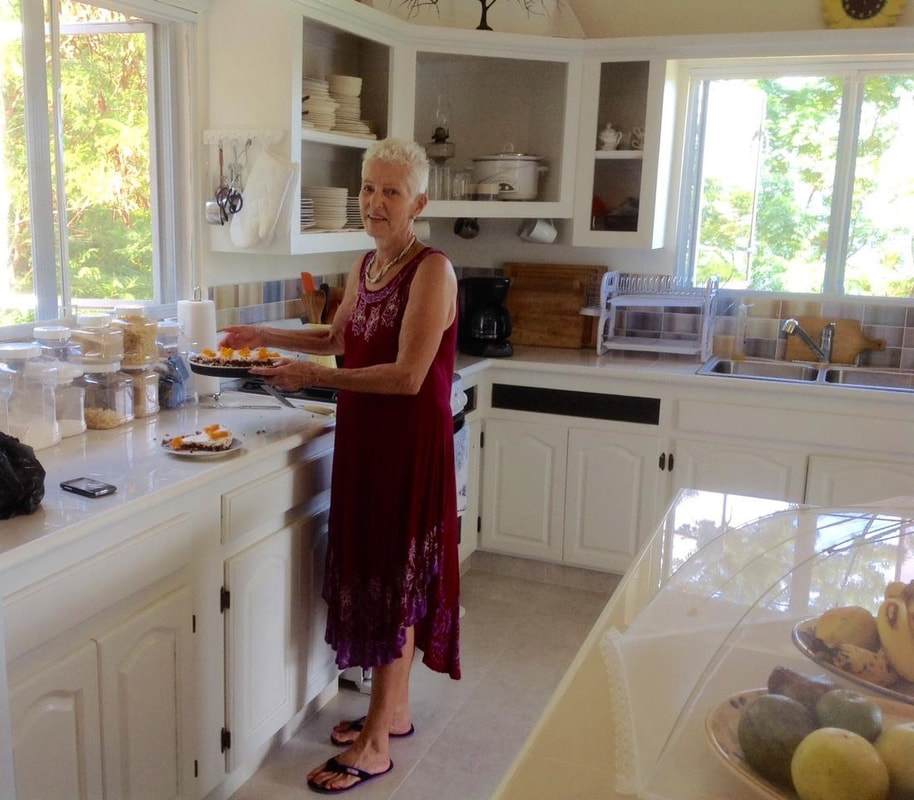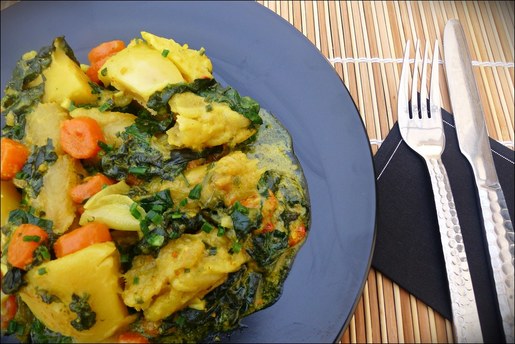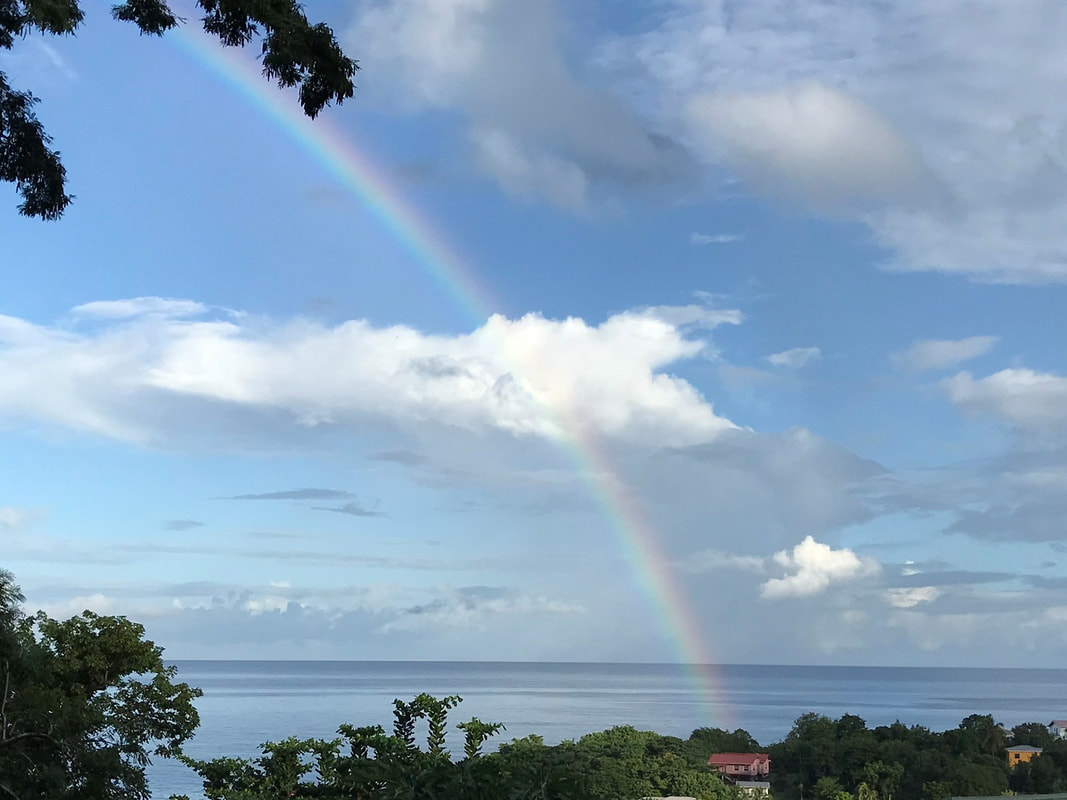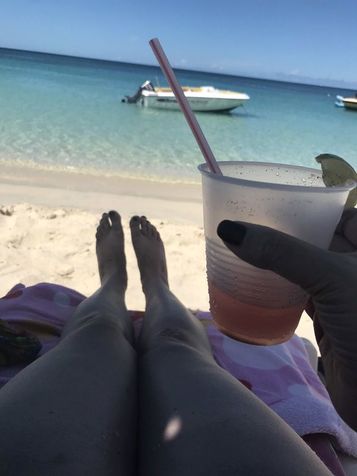|
My ego ideal Susan Good, aka Honey Good entertains in a style I admire but would never be able to pull off, especially not here in Grenada. She sets an elegant table with fine China, crystal, flowers, place cards for guests, the whole nine yards.
Not I. I love entertaining but have had to make allowances for living in the tropics and the fact that my guest list is usually large, not a number that can be seated at an elegant table. Then there are the constant breezes, which would knock over flower vases, blow away napkins and other decorations. So, I entertain with an air of informality. My China or glasses often don‘t match, the tablecloth is taped to the table to keep it from being blown off. Instead of an elegant table, we lay the hors d’oeuvres on the kitchen island. Plates, glasses cutlery, drinks, napkins, are on the dining table and food is on the counter on heated trays. It is strictly a self-service deal. I do put up appropriate decorations but again, I have to bear in mind that it will all have to be anchored so the wind does not blow them away. People sit on the veranda at small tables or inside the open plan living/dining/kitchen area as they please. We eat, we mingle, swap seats, laugh, gossip and the time flies by. To me this is the most enjoyable way to entertain.
0 Comments
 A visit from my grandkids is always an occasion of joy for me. They’re all unique, they love Grenada & now that they’re adults, organizing activities has become a lot less work/worry. That said, the particular challenge this year was trying to shop for twins Jenny & Thea who are strict vegans. While legumes & fresh vegetables, fruits & nuts are readily available, many items are not. Vegan cheese & yogurt as well as a host of other items are not, or only sporadically. When they are available, they are carried by only one supermarket, so we often had to go out of our way to do our shopping. To their credit, they were pretty good at selecting nutritious items in spite of the challenge. One thing they debated over, was whether to buy soy milk (not their favorite) or almond milk. The latter’s manufacturing requires the use of a great deal of water, as almond trees need lots of water. Almond milk is also much more expensive. Since they’re in an environmental sciences curriculum at college, they are very aware of these differences. We found tofu soy granules, all sorts of pasta and on occasion even a package of grated vegan cheese. Hummus was also available. The girls are pretty good cooks, so their cousin, Tabitha, Dick & I didn’t feel deprived. Cost, of course, is something else again. As there’s very little demand & turnover for these items, the prices are astronomical. Luckily, grandma is still at the stage where spoiling them is part of the deal. As the girls do Google cooking (i.e. find recipes on Google) they tried to insist that only a certain brand of condiment would do. I managed to convince them that hot sauce was hot sauce, no matter what brand & as long as it didn’t contain anything they couldn’t eat, it would do just fine, Ditto for soy sauce, vinegar, salt, sugar, etc. The end result of all this is that some of the recipes were so good, I’ve started making some vegan dishes for us & a friend who is also into vegan. The only exception is that I can’t quite get used to apple sauce instead of yogurt or sour cream in some recipes. Knowing our grandchildren into adulthood is one of life’s great privileges. My granddaughters’ dietary requirements created an interesting, delicious culinary journey within a journey for all of us, this visit. But when I reflect, it’s also an excellent metaphor for the adventurous learning of new things for which they have become my eager scouts, guides & companions. Everyone who knows me, knows I love to cook & entertain. This has taken on a special meaning since we moved to Grenada. Like us, many friends have family far away, so holidays can be a bit sad. At some point, I decided that if I couldn’t have my family with me, I would make one from my friends.
As Easter approached, I started putting together the guest list & the menu. I’m fairly well-organized, so no problem. Easter here is a four-day celebration with Saturday being the only day when stores are open & market vendors present. I had everything except for the meat for the main course. Lamb, my traditional Easter main course is horribly expensive here, so I substitute leg of goat, which is like lamb without the fat. So, on Saturday, off I go to market early, after having left a message for my meat vendor, Petra, to set aside a nice leg of goat for me. Problem: no Petra, no goat. OK, plan B, let’s get a nice leg of pork for a pork roast. Problem: no pork left. OK, plan C, get some beef for a nice roast. Problem: the only beef left is a leg, the vendor tells me, a young cow. I buy it, thinking I’ll figure out how to carve this thing. Problem: it’s not enough to feed 18 people. Plan D, buy a couple of chickens, so off I go the supermarket. Problem: no chickens left except for 4 legs with thighs, which I have to buy. On Easter Sunday, I manage to fit the leg of beef (calf?) into the oven, use the downstairs kitchen to bake the chickens, all is turning out well. As the guests start to arrive, I ask who is brave enough to tackle carving the leg. Finally, Vittoria, who is a superb cook, past restaurant owner, volunteers & does a fantastic job. As a bonus, she gets to take home the huge bone for her dog. All eat heartily, rave about the calf, the chicken & all enjoy the many contributions from guests; not traditional Easter fare, but who cares? One of the joys of living on a tropical island is the endless variety of edibles. As I love to cook & entertain and am naturally curious about all things edible, I’m always experimenting with new foods.
Breadfruit & I go back some 48 years, when my then husband & I were running a large sailing charter boat. We had a full crew, including a chef but on weekends when the crew was off, I did the cooking for the 3 of us who remained on board. One day I was preparing a meal when one of the crew members came on board, delivering a treat is wife had cooked. Grenadians are among the most generous people I’ve ever come across, so this was welcome but not entirely a surprise. As he came into the galley, he saw me trying to peal a breadfruit, struggling mightily, as the breadfruit is about the size of a medium cantaloupe & the skin is really hard to get off. The crew member watched & when he couldn’t watch any more, took it from me & showed me how to do it. Cut it in quarters, cut out the soft, seeded middle & then peel the quarters. Nowadays, though I know how to do it, I ask the market vendors to cut up the breadfruit, cut out the soft middle & when at home, ask hubby to peal & cut it up. This amazing vegetable is one of the most versatile edibles there is. We use it cubed & boiled, as we would boil potatoes, we cut it into long thin pieces for breadfruit fries, we mash it, we bake it & for those who have access to charcoal, it can be roasted whole in the ashes. Best of all, unlike potatoes, it freezes well. So now for some facts about this wonderful food. Breadfruit originated in the South Pacific and was brought to the Caribbean in the late 18th century. Not only was the fruit used but also the timber from the tree in ship and house building. The breadfruit tree is one of the highest producing plants with 200 plus fruits per tree per season. It is 71% water, 27% carbohydrate and many essential trace minerals. For more detailed information, please visit www.wikipedia.org/wiki/Breadfruit. Oil down is the national dish of Grenada with a long, interesting history. The name comes from the oil from the coconut milk and the meat juices that settle on the bottom of the pot when the dish is ready to eat.
The origin of the dish is during slavery when slaves from neighboring estates would get together to share a meal. This was not only a practical way of combining scarce resources but also a way to socialize. Each person would bring what they could salvage from the master’s larder, hence the varied ingredients. By each person contributing, each felt comfortable in sharing in the meal. In modern times, cooking oil down is usually a family or community event, much like our American BBQ. There are as many ways to cook oil down as there are families who cook them, but the basic ingredients are pretty much the same: breadfruit, coconut, salt meat or fish (these were brought by ships from Europe in previous centuries & constituted the main ingredient in the diet of seamen as well as the diet of slaves), dumplings, turmeric and callaloo. The latter is the only ingredient native to Grenada, used by the original Amerindian inhabitants of the island. Since I like to cook & try new recipes, I decided to cook oil down. The result will be recorded in my upcoming book “Caribbean Cooking Disasters”. I put too much water with the grated, fresh coconut, the requisite coconut milk was too thin. I put the callaloo in the bottom, so it became a sticky mess, I didn’t soak the salt pork long enough, well, you get the idea. But I learned & herewith is my own recipe for oil down: INGREDIENTS:
 The MV Berlin The MV Berlin I did not see an ocean or sea until the summer before my 17th birthday. It was not an auspicious introduction. We had boarded the MS. Berlin, a passenger liner which had regularly ferried people between the Old World and the New. Though by today’s standards she would be subpar, for 1958, she was luxurious. Once all luggage was stowed, cabin assignments sorted out, on board rules & regulations explained, drawings of the various parts of the ship, stores, eating facilities, library, bars, swimming pool, etc, I immediately went below to our cabin & lay down. I don’t now remember where the rest of my family members were, but I was the only one in our cabin. After about 15 minutes, a knock came & one of the ship’s officers told me to get up & get on deck, no matter how terrible I felt. He assured me that if I did not do this, I would spend the rest of the crossing in my bed. I heeded his advice & the scene on deck was not pretty. Many were leaning over the railing, doing what my mother called “feeding the fish”. However, the officer turned out to be right & the nausea slowly subsided & as the clouds cleared & the sky brightened, I felt much better. I could now marvel at the vastness of the sea, the gulls that followed us, the hum of the engines & all was well with the world. The passage took 12 days with a stop in Halifax, Nova Scotia. On-board life was wonderful, with any number of activities, shuffle board, swimming, dancing at night, lounging in the cool sun on deck chairs, with drinks being served by stewards. There was one other storm to weather but by then I had my sea legs & could only be amused by the storm’s effect. I was swimming & suddenly all the water sloshed out of the pool, overflowing the surrounding tiles & I was on my stomach in an empty pool. The arrival in New York was suitably impressive with Lady Liberty on guard. We settled in Chicago & it was another 7 years before I saw the sea again. For my second encounter it was the Pacific Ocean in Acapulco, Mexico where a friend & I had gone on vacation. This sea was magnificent with deep colors, a white, sand beach & a great variety of sea birds to watch. Swimming was so easy, the salt water so much more buoyant, the water warm, compared to Lake Michigan waters. I couldn’t get enough of it. The next year, another friend & I went to Mexico again, this time to Puerto Vallarta, which then was just a sleepy village with 2 hotels. By now I was truly in love with the sea. Two years after this trip, in 1968, I went on a Windjammer cruise to the West Indies & saw the Atlantic as well as the Caribbean Sea. It was pure magic, with snorkeling over pristine coral reefs, lazing on powdery white beaches & I was hooked for life. In 1971 I returned to the West Indies, where my then husband & I ran a large sailing passenger boat for 8 months until it was sold. Our cruises went from the south, the Grenada Grenadines to north, the St. Vincent Grenadines. The seas were kind, the colors magnificent. My crew worked hard to allow me the most time to swim & snorkel, we had lobster every week, life was grand. While negotiations were going on to sell the boat, we were anchored in Trinidad, the Gulf of Paria, with Venezuela visible on clear days. After she was sold, we went to England & I met a very different sea. The North Sea is dramatic, restless, cold, temperamental but awe inspiring to watch. Swimming was a shock to me after the warm waters of Mexico & the West Indies, but that was not the only North Sea experience. My then husband & I bought a coasting freighter to carry general cargo to the Scandinavian countries, Poland, Holland, Belgium & England. We did this for the better part of 9 months. The North Sea demands great respect. It can be the roughest, most frightening monster or it can be a marvel of nature, from pancake ice in the Norwegian Fjords to the placid green of the open stretches to the northern lights. When rough, you just hope to either die on the spot or pray for stepping ashore the soonest possible. I remember one particularly bad storm, sitting in my cabin, watching through the port hole, the violent peaks and valleys created by the powerful waves; the pitching of our vessel, making a mockery of the horizon line. And yet, I loved this awesome sea. And so, in 2013, we retired & chose Grenada as our permanent home. I now look out at the Caribbean Sea from my house. She is placid, but never the same on any given day. I sit & watch her moods through all seasons & she soothes my soul. Several times a week I go swimming. The water carries me, caresses me, restores me. The beach is ideal for a long walk, people watching, watching boats of all kinds come & go. I look at the tourists & think, they pay thousands of dollars for this & it’s mine any day of the week. I never lose sight of the fact that I’m very fortunate. The sea is my restorative medicine; my friend for the rest of my life. 1 cup of fresh lime juice
2 cups of grenadine syrup 2 cups of Caribbean rum 1 cup of coconut rum 2 cups of pineapple juice 2 cups of orange juice 5-8 drops of Angostura bitters A dash of nutmeg Orange, lime and/or pineapple slices for garnish. Mix ingredients together and be sure to add crushed ice or ice cubes before serving. |
AuthorHi I'm Maria Davies. On this blog I share my life in the Caribbean as well as my passion for mentoring, food, travel and fitness. Enjoy! Archives
April 2024
|






 RSS Feed
RSS Feed